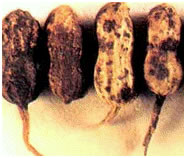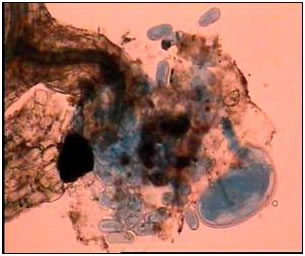|
Pod Scab nematode Kalahasti malady : Tylenchorhynchus brevilineatus
Symptoms
- Infected plants appear in patches in the field and stunted with pale greener than normal foliage.
- Small, brownish lesions appear on the pegs, and on young developing pods.

- Small, brownish lesions appear on the pegs, and on young developing pods.
- In advanced stage, entire pod surfaces become blackened.
- Discolouration can also be observed on roots.
Management
- Grow resistant varieties
- Crop rotation with rice
- Irrigate the field.
- Apply carbofuran 3G @ 1.0 kg a.i/ha 25 -30 days after sowing along with irrigation water.
- Application of gypsum @ 200 kg/ha at the time of earthingup.
Crop Rotation:
- Tagetes erecta was a poor host for T. brevilineatus. As a rotation crop, it reduced nematode populations in soil and pod disease severity and increased groundnut pod yield.
- Mustard also significantly increased pod yield (Naidu et al, 2000b).
Castor
Reniform nematode: Rotylenchulus reniformis
Symptoms:
- Above ground symptoms on host plants include dwarfing, shedding of leaves, formation of malformed fruit and seeds, and general symptoms of an impaired root system.
- Below ground, roots are discolored and necrotic (dead) with areas of decay. Plant mortality is possible in heavy infestations.
Management
- Application of carbofuran 3 G @ 1.0kg a.i/ha
- Rotation of soybeans with corn, sorghum, and wheat reduced populations of reniform nematode.
- Application of FYM @ 10 t/ha or neemcake @ 500 kg/ha
 
|

